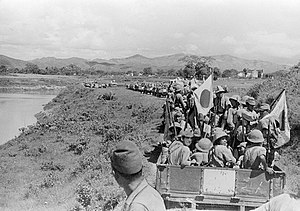
Back الغزو الياباني للهند الصينية الفرنسية Arabic Ocupación xaponesa d'Indochina AST Японско нахлуване в Индокитай Bulgarian Ocupació japonesa d'Indoxina Catalan Invasionen af Fransk Indokina Danish Japanische Invasion Französisch-Indochinas German Ocupación japonesa de Indochina Spanish حمله ژاپن به هندوچین فرانسه Persian Ranskan Indokiinan valtaus Finnish Invasion japonaise de l'Indochine French
| Japanese invasion of French Indochina | ||||||||||
|---|---|---|---|---|---|---|---|---|---|---|
| Part of French Indochina in World War II, the South-East Asian theatre of World War II and the Pacific Theater of World War II | ||||||||||
 Imperial Japanese Army soldiers advance to Lang Son, in September 1940 in French Indochina. | ||||||||||
| ||||||||||
| Belligerents | ||||||||||
|
|
| |||||||||
| Commanders and leaders | ||||||||||
|
|
|
| ||||||||
| Casualties and losses | ||||||||||
| Unknown | Uncertain (~900 according to sources) | Unknown | ||||||||
The Japanese invasion of French Indochina (仏印進駐, Futsu-in shinchū), (French: Invasion japonaise de l'Indochine) was a short undeclared military confrontation between Japan and Vichy France in northern French Indochina. Fighting lasted from 22 to 26 September 1940; the same time as the Battle of South Guangxi in the Sino-Japanese War, which was the main objective as to why Japan occupied Vietnam during this time.
The main objective of the Japanese was to prevent China from importing arms and fuel through French Indochina along the Kunming–Haiphong railway, from the Indochinese port of Haiphong, through the capital of Hanoi to the Chinese city of Kunming in Yunnan.[1]
Although an agreement had been reached between the French and Japanese governments prior to the outbreak of fighting,[2] authorities were unable to control events on the ground for several days before the troops stood down. As per the prior agreement, Japan was allowed to occupy Tonkin in northern Indochina, and thus effectively blockade China.
- ^ Liardet, Jean-Philippe. "L'Indochine française pendant la Seconde Guerre mondiale" [French Indochina during World War II] (in French). Archived from the original on 5 February 2012.
- ^ Cooper, Nikki. "French Indochina". Port.ac.uk. Retrieved 11 November 2021.